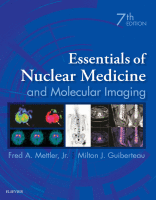Physical Address
304 North Cardinal St.
Dorchester Center, MA 02124

Liver-Spleen Imaging Computed tomography (CT), magnetic resonance imaging (MRI), and ultrasound offer better anatomic display of liver and spleen architecture than does radionuclide liver-spleen imaging, which is rarely performed. However, there remain a few indications for technetium-99m ( 99m Tc)…

Radionuclide lung imaging most commonly involves the demonstration of pulmonary perfusion using limited capillary blockade, as well as the assessment of ventilation using inspired inert gas, usually xenon, or technetium-99m ( 99m Tc)-labeled aerosols. Although these studies are essentially qualitative,…

Clinical nuclear medicine studies play a pivotal role in the noninvasive evaluation of cardiac physiology and function. Their widespread use permits the sensitive detection and functional consequences of numerous cardiac abnormalities. About 50% of all nuclear medicine studies done in…

Thyroid Radioiodine Uptake and Imaging The use of iodine-131 ( 131 I) for measuring thyroid functional parameters and imaging the gland has historically served as a nucleus in the evolution of the field of nuclear medicine, as well as molecular…

Radionuclide Brain Imaging In specific clinical settings, radionuclide planar, single-photon emission computed tomography (SPECT), or positron emission tomography (PET) brain imaging can provide valuable functional and perfusion information about suspected cerebral abnormalities or cerebrospinal fluid (CSF) dynamics that is not…

Geiger-Mueller Counter Geiger-Mueller (GM) counters are handheld, very sensitive, inexpensive survey instruments used primarily to detect small amounts of radioactive contamination. The detector is usually pancake shaped, although it may be cylindrical ( Fig. 2.1 ). The detector is gas…

Basic Isotope Notation The atom may be thought of as a collection of protons, neutrons, and electrons. The protons and neutrons are found in the nucleus, and shells of electrons orbit the nucleus with discrete energy levels. The number of…